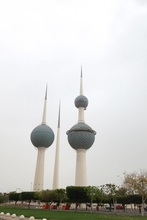 Moises Bernal and I on our last dive of the trip in Las Perlas Moises Bernal and I on our last dive of the trip in Las Perlas The month of May saw the LSU ichthyology lab collecting in drastically different places on the globe. Prosanta and I finished up our Middle East collection at the beginning of May, and shortly after I found myself traveling with Moises Bernal, University of Texas graduate student who is completing his research at the California Academy of Science, to his homeland of Panama. The trip was funded by the American Museum of Natural History Lerner Grey Grant and the LSU Museum of Natural Science, and while we collected a variety of species, our main goal was to collect the sawtail surgeonfish, Prionurus laticlavius, for one of my dissertation chapters. The hot and dry conditions we experienced in the Middle East had no resonance in the wet, humid, tropics of Central America. Our trip was brief, leaving us a limited number of sampling days for the Pacific coast of Panama. However, rough sea conditions arrived with us, resulting in the Smithsonian Tropical Research Institute (STRI) halting all marine operations for several days. Luckily the weather did stay too long, and with the hard work of STRI boat organizer Reinaldo Tapia and STRI dive safety officer Raul De Leon we got several days of diving through STRI at Isla Taboga, near the STRI Naos lab, and in Las Perlas Archipelago. To get back some of the days we lost due to weather, Moises and I decided to dive throughout the weekend and got in touch with Guillermo Schuttke at Coral Dreams dive shop on Contadora Island in Las Perlas. Guillermo was a tremendous help, and used his decades of experience in Las Perlas to help us find the fish we were looking for quickly. Overall it was a great trip, and I hope to return to Panama in the near future for more collections. Thanks to everyone who helped us get our fish.  Kuwait Towers. An iconic landmark on the waterfront. Kuwait Towers. An iconic landmark on the waterfront. During the last half of April this year Prosanta and I headed back for another trip to Kuwait. Last year we had visited LSU Museum associate Jim Bishop, who works at the Kuwait Institute for Scientific Research (KISR), and brought back around 500 specimens for LSU that Jim had helped collect over the years. This year we were invited back out by KISR to teach an intensive short course on ichthyology for research scientists and government employees from the Arabian peninsula. The course was titled "Taxonomy and Identification of Fishes from the Arabian Gulf", and had around 20 students enrolled. Each day of class started with a lecture in the morning regarding systematic ichthyology, followed by an afternoon in lab where students got hands on experience identifying fishes that were caught in trawls earlier in the week. We showed the students how to differentiate between the common families in the area, and what to look for to determine the species they had. I taught a lecture on the geology and historical biogeography of the region, and Jim Bishop gave an excellent lecture on the history of ichthyology and collecting in the Arabian Gulf, which included him showing the class plates from his original prints of Forskal. It's not too often that you get to see original prints from a book that is several hundred years old, and everyone in the class was enthusiastic to see that. Overall the class went well, and in the future might be offered every several years. In addition, the specimens that were collected for the course were packed up and will be housed at the LSU Museum of Natural Science, further increasing our collection of fishes from the Arabian Gulf. After the course concluded, Prosanta and I travelled to Abu Dhabi in the United Arab Emirates to visit with an acquaintance of Jim's and collect more fishes. We met up with the lab of Dr. John Burt at New York University Abu Dhabi. John graciously showed us around town to the fish market and let us use his lab space for our work. The NYUAD campus is brand new, and was extremely nice. There are some species that you don't see in Kuwait that are found further south in the gulf by UAE, so it was good to get collections of these species too. While in UAE we also managed to take a side trip for a day to Dubai, where we got to go up the tallest building in the world, the Burj Khalifa. That was a real treat to see, and it's always good to have a day off in the field after working for a couple of weeks straight. Overall it was a very successful trip to the Middle East. It would not have been possible without the help of Jim Bishop, KISR, John Burt and his lab, and NYUAD. So a HUGE thanks goes out to those people. Hopefully we'll get to go out to this area of the world again in the near future. |
Archives
August 2021
Categories |